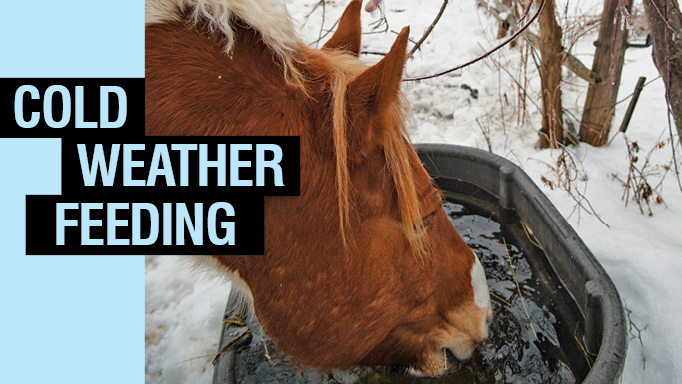
Horses enjoy cold weather and the relaxation that winter brings, but it takes more than hay to keep them healthy during the colder months. Optimal nutritional planning will help them enjoy the season and emerge in good condition when spring arrives.
Hay is not enough
Hay cannot compare in nutritive value to fresh grass. Once grass is cut, dried, and stored, it begins to lose vitamins C, D and E, beta carotene (for vitamin A production), and omega-3 fatty acids. Normally, your horse produces vitamin D when he is exposed to sunlight. But spending more time indoors, combined with shorter daylight hours, can induce a vitamin D deficiency that leaves bones, joints, and muscles unprotected. Therefore, a vitamin supplement, along with ground flaxseed or chia seeds (to provide omega 3s), will fill in the nutritional gaps created by hay-only diets.
Consider alfalfa
Contrary to popular opinion, alfalfa it is not higher in sugar than grass hay. It is high in protein, but this is a good thing. At a moderate intake (approximately 10 to 30 percent of the total hay ration), it boosts the overall protein quality of the diet, keeping your horse’s muscles, joints, feet, skin, hair, and bones fed, and protecting his blood and immune function. Alfalfa also serves as a stomach buffer against developing an ulcer, a common occurrence when a horse is stalled during the winter after being used to full-time turnout.
Offer hay free-choice
Cold weather increases the metabolic rate, which means that horses need to burn more calories to maintain a normal internal body temperature and a consistent weight. When you provide hay free-choice, you will notice that your horse naturally consumes more to help stay warm and account for his higher energy need. Free-choice is always best (regardless of the season or condition of your horse) because it allows your horse to self-regulate his intake and eat only what his body needs. Consider testing your hay; choose hay with low sugar and starch levels for the insulin resistant, laminitic, or overweight horse.
For more calories, add concentrates
For many horses, hay will not provide enough calories to maintain normal body condition. A high fat commercial feed is fine for healthy horses. For the easy keeper or insulin-resistant horse, avoid sweet feeds and those that contain oats or corn. Beet pulp, alfalfa pellets, or low starch commercial feeds are excellent alternatives. Fatty feeds such as rice bran, ground flaxseed, chia seeds, or hempseeds offer the most concentrated source of calories. Avoid corn or soybean oils, since they promote inflammation due to their high omega-6 fatty acid content.
Older horses need special attention
Your older horse may need a joint supplement along with vitamin C to help produce collagen (the protein found in bones and joints), since less vitamin C is produced by the body as horses age.
For the aged hard keeper (or any hard keeper, for that matter), be sure there is no competition from more aggressive horses for hay. Feed a senior feed, along with added ground flaxseed, chia, or hempseeds. And be sure to check your horse’s teeth. Poor dental health is the number one reason for weight loss in older horses.
Other tips
- Use a prebiotic (fermentation product, not live microbes) or a potent probiotic (one that contains billions – at least 109– colony forming units, or C.F.U.s) to keep the hindgut microbial population healthy.
- When feeding bran mashes, or any added feed, feed it every day. Consistency will prevent colic. Keep in mind, however, that bran (rice or wheat are most common) is very high in phosphorus in relation to calcium. Therefore, use a commercial product with added calcium or feed alfalfa to counteract the elevated phosphorus content.
- Provide fresh, temperate water. Never rely on snow to meet your horse’s water needs.Water should be kept at a palatable temperature to encourage drinking and prevent dehydration.
- Remember to provide salt. Salt blocks, free choice granulated salt, or adding two tablespoons of table salt to your horse’s meals per day (divided between meals) will keep his body in proper water balance.
Supporting Materials
Winter has its challenges. If you’re living in a warm, southern climate, you don’t experience the blizzards found in the north, but the weather changes can still impact your horse in a variety of ways. Here are some things that every horse owner needs to consider:
- Forage will often shift from pasture to hay. Anytime the diet changes, it should be gradual to allow the hindgut microbial population to adjust.
- Not all hay is alike. Have it tested to be certain that it doesn’t contain too much indigestible fiber (NDF), has adequate protein, and the percent ESC + Starch is not too high for the insulin resistant horse.
- Hay does not contain all of the vitamins that fresh grass does. Therefore, it is essential to offer a comprehensive vitamin/mineral supplement along with a source of omega 3 fatty acids (such as ground flaxseeds or chia seeds).
- All horses should have their teeth checked for points that can make chewing painful. Hay is more difficult to chew and the teeth need to be in top shape.
- Water consumption needs to stay at optimal levels. Since most horses do not drink enough water when it’s icy cold, it is best to use a heated water bucket to bring the water temperature up to 50 degrees F. Dehydration due to decreased water consumption is the main cause of colic during the winter.
- Don’t forget to continue offering salt. Salt blocks are made for cattle, that have scratchy tongues. Horses’ tongues are smooth and they will often avoid salt blocks because they irritate the tongue, causing small cuts. It is better to offer coarsely granulated salt, free choice. Start out with a small amount so your horse’s curiosity won’t result in him eating a big mouthful of salt. Once he sees that it’s salt, you can fill the container with enough to last for a few days.
- Avoid blanketing your horse if at all possible. The winter coat is designed to keep your horse warm and regulate his internal body temperature. Horses should, however, have access to a shelter to get out of the wind, rain, and heavy snow so their skin remains dry. Blankets flatten the coat making it unable to protect your horse against extreme cold. If your horse is very thin, or clipped, and you find that a blanket is necessary, check his condition each day to make certain he is not sweating
- Hay digestion produces heat and horses should not run out of hay at any time. This is true throughout the year, but especially important for keeping your horse in good condition.
- Consider adding alfalfa – it acts as a buffer against ulcer formation for horses that are stalled. Plus it boosts protein quality to keep your horse in good health.
If your horse in underweight, help him gain weight by:
- Adding fat to the diet. Avoid soybean, corn, or wheat germ oils – they are much too high in inflammatory omega 6 fatty acids. Choose flaxseed meal or rice bran (stabilized and commercially fortified with calcium), or you can rice bran oil for extra fat.
- Pay attention to the hindgut microbial population because they are responsible for digesting fiber from forage. Your horse will not derive calories from hay if the hindgut microbes are not in good numbers. A Prebiotic – fermentation products that feed microbes – is the best approach toward helping your horse gain weight.
If your horse is overweight, do not restrict grass hay.
- Have it tested to make sure the ESC + Starch percentage is less than 11% on a dry matter basis.
- Feed this low starch hay, free choice, and allow your horse to self-regulate his intake. He will do this if given the chance – meaning, he doesn’t ever run out of forage.
- Offer supplements in a low starch carrier meal, such as beet pulp or hay pellets (some alfalfa is good and it is very low in sugar and starch).
- Avoid cereal grains, sweet feeds, and sweet treats (carrots, apples, commercial treats that contain cereal grains).
By Juliet M. Getty, Ph.D.



